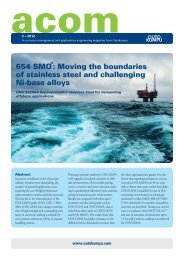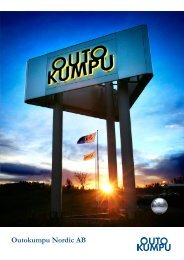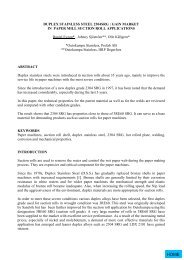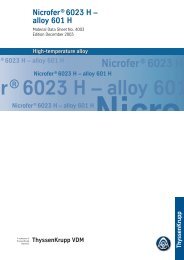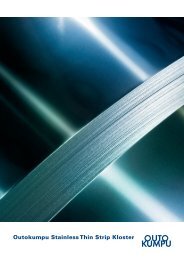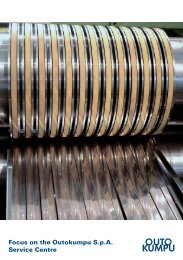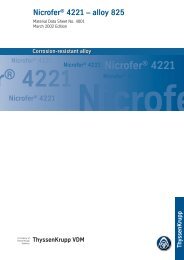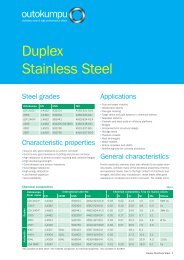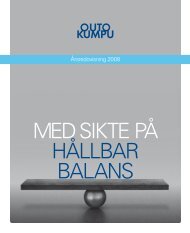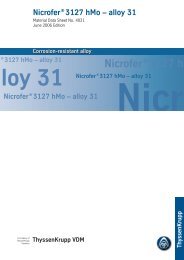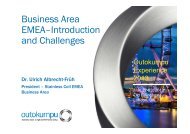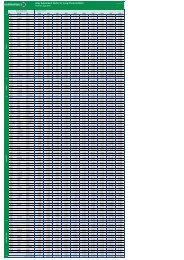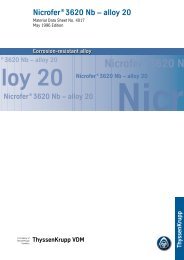Annual Report 2010 - Outokumpu
Annual Report 2010 - Outokumpu
Annual Report 2010 - Outokumpu
Create successful ePaper yourself
Turn your PDF publications into a flip-book with our unique Google optimized e-Paper software.
87<br />
studies monitoring the prevailing biological, physical and chemical conditions have been carried out near the Tornio site<br />
since the 1970s. In 2008, results of voluntary research concerning the impact of nitrates on recipient water at the Tornio<br />
site and the Kemi Mine were published. These showed that impacts are restricted to the immediate proximity of the<br />
discharge points at Tornio and cause slight eutrophication. At the Kemi Mine, the impacts on sea areas are essentially<br />
negligible.<br />
Pollution prevention techniques being employed by <strong>Outokumpu</strong> mean that increases in emissions can be avoided, and<br />
further reductions from earlier emissions levels will be achieved in many cases even at higher-than-current production<br />
levels. <strong>Annual</strong> studies carried out by Pöyry, a consulting company, have shown that impacts on the sea areas close to<br />
the Group's production plants have diminished during the last ten years and that the associated marine ecosystems are<br />
in good health.<br />
A number of studies which include the continuous monitoring of discharge levels have shown that discharges of<br />
chromium and nickel are now 60–80% below levels measured ten years ago. Considered to be the most significant<br />
metals released into the sea by <strong>Outokumpu</strong>'s production activities at Tornio, current discharges of chromium and nickel<br />
only represent a fraction of the total metal loading, which originate in the main from natural sources in the northern part of<br />
the Gulf of Bothnia. This is because Tornionjoki and Kemijoki, the two local rivers, carry far greater concentrations of<br />
these metals into the sea than the combined amount discharged by the Group's facilities. Activity in local fisheries<br />
located near the Tornio Works is at healthy levels and commercial fishing operations are carried out close to the<br />
production plant. Research indicates that the metals released from the <strong>Outokumpu</strong> facilities do not accumulate in the<br />
marine food chain.<br />
Continuing measures to improve the condition of the Baltic Sea<br />
<strong>Outokumpu</strong> is participating in the Baltic Sea Challenge as mentioned in the programme published at the beginning of<br />
<strong>2010</strong>. We use the practical measures already instituted at our Tornio Works in the 2000s and will also take action in the<br />
future to improve the condition of the Baltic Sea. In <strong>2010</strong>, the required effluent permit was amended permitting us to take<br />
into use the 70 hectare-suction-dredging basin for effluents before they are discharged into the sea. During 2011–2012,<br />
the sanitary treatment facility of Tornio Works will be modernised to fulfil the new stricter efficiency requirements coming<br />
into force in 2013. These measures will help us reduce our impact on the Baltic Sea.<br />
See the Baltic Sea Action programme.<br />
<strong>Outokumpu</strong> <strong>Annual</strong> <strong>Report</strong> <strong>2010</strong> – Business – Biodiversity




